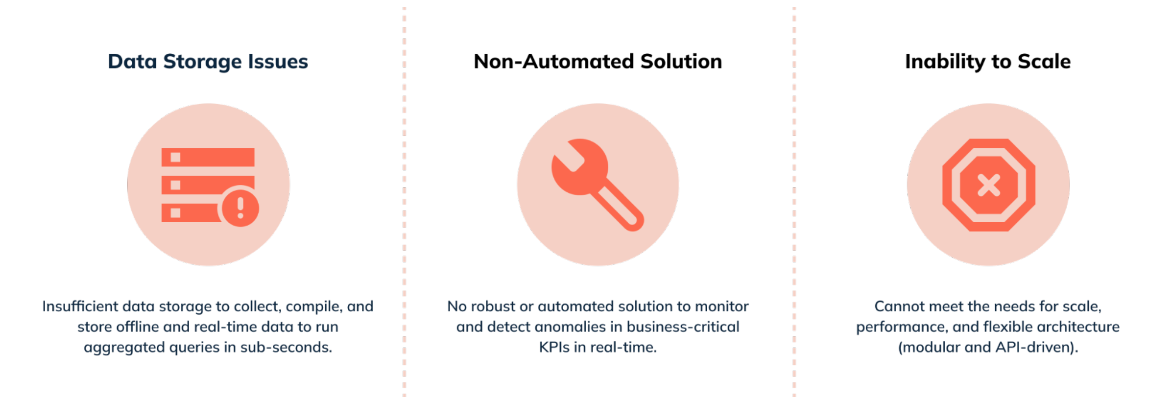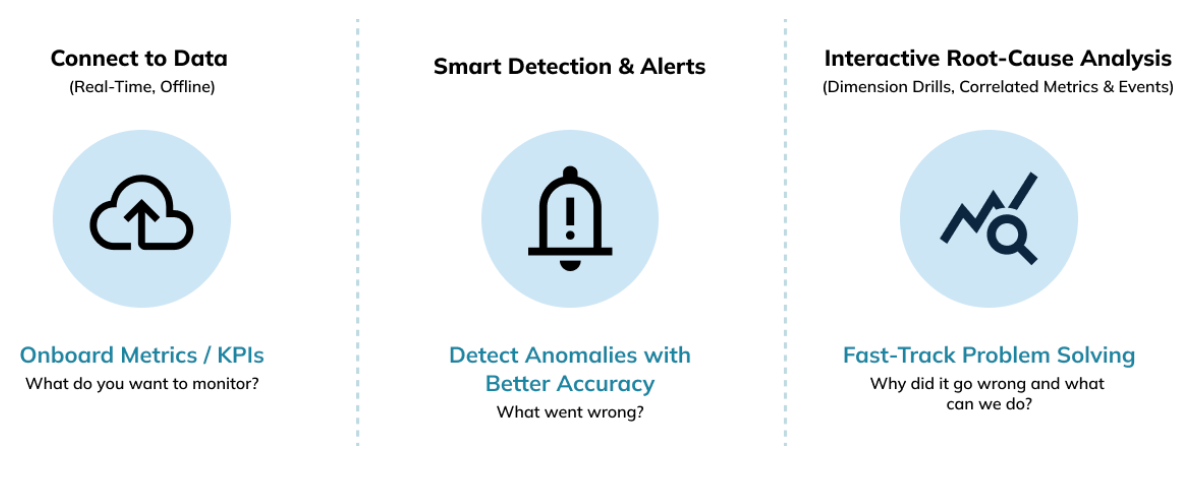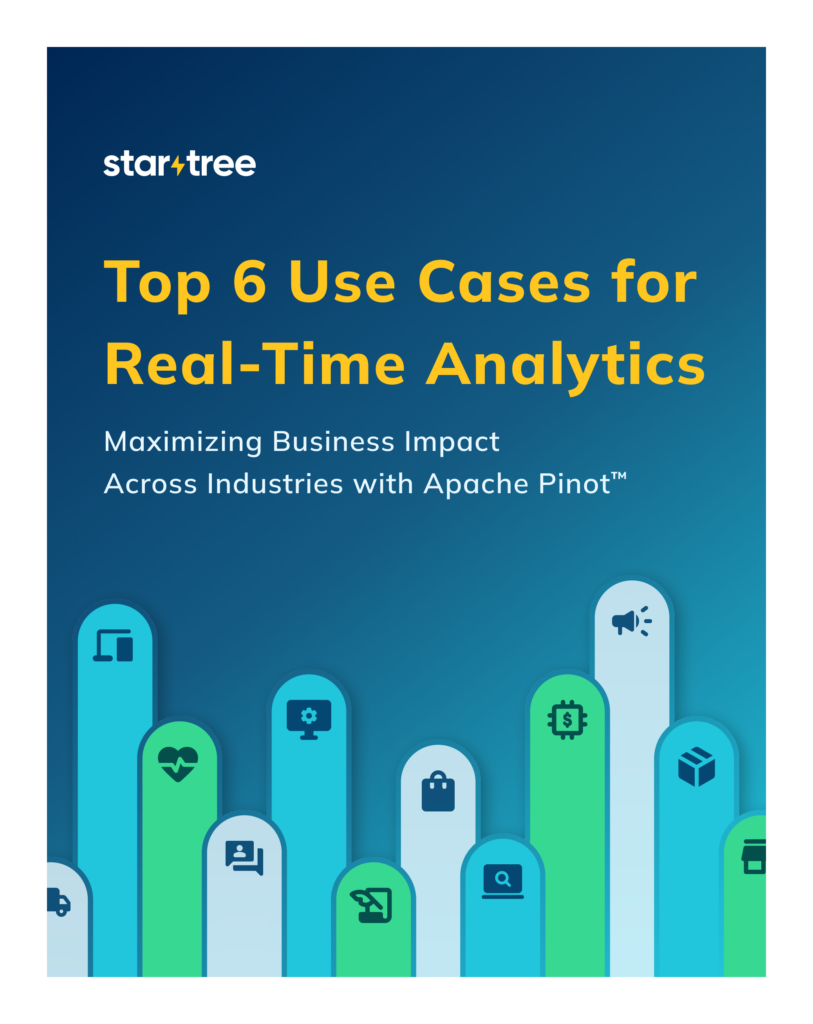Anomaly detection for a world on the move
In the complex world of logistics, delivery and ridesharing, industries face numerous challenges, including intricate supply chains, growing customer demands, traffic congestion, and the need for high safety standards. Anomaly detection has become crucial in these sectors, identifying deviations from normal patterns to pre-empt disruptions.
Anomaly detection enables businesses to stay agile and competitive, transforming operations for better profitability and customer satisfaction. It’s a necessary tool for navigating the challenges in logistics and ridesharing, guiding companies toward success in a dynamic environment.
Why is anomaly detection important in logistics, delivery, and ridesharing?
Anomaly detection is important in logistics and ridesharing for several reasons:
- Reduced costs: By proactively identifying and addressing anomalies, companies can minimize costly disruptions such as delays, lost shipments, rider dissatisfaction, driver safety and accidents, and driver misbehavior.
- Enhanced efficiency: Timely deliveries, accurate order fulfillment, smooth rides, optimal driver allocation, and efficient fuel consumption contribute to overall efficiency and customer satisfaction.
- Improved safety: Anomaly detection helps identify potential safety hazards, enabling companies to take preventive measures and protect both employees, customers, and riders.
- Disruptions and downtime: Unexpected events, such as natural disasters, equipment failures, or driver shortages, can disrupt operations and lead to downtime for logistics and ridesharing companies that do not use anomaly detection.
Which types of anomaly detection do logistics, delivery, and ridesharing companies use?
Logistics and ridesharing companies use a variety of anomaly detection techniques, including:
- Statistical methods: These methods analyze historical data to identify deviations from expected patterns.
- Machine learning algorithms: These algorithms learn from data to identify anomalies in real-time.
- Rule-based systems: These systems define rules based on expert knowledge to identify specific patterns that indicate anomalies.
- Graph-based anomaly detection: This approach utilizes graph structures to model complex relationships between entities, enabling the detection of anomalies that may not be apparent in traditional methods.
Learn more about the anomaly detection landscape and the main types of anomaly detection models.
As an example, rideshare companies managing rideshares and timely supply and logistics of drivers use anomaly detection to monitor a few crucial metrics such as:
Growth :
- Adapting to weather conditions
- Responding to traffic congestion
- Ensuring efficient delivery routes
Revenue :
- Managing order cancellation rates
- Reducing undelivered packages
Operations :
- Monitoring driver wait times for on-time deliveries
- Detecting unexpected delivery delays
- Monitoring driver performance
- Maintaining inventory levels
- Managing fuel expenses and emissions
When anomalies occur, like extended driver wait times or sudden order spikes, anomaly detection helps the company take proactive steps, such as deploying extra drivers, adjusting routes, or addressing driver issues. This streamlines operations, reduces costs, and enhances customer satisfaction in real time. [ Watch a demo on how to monitor extended driver wait times using StarTree ThirdEye.]
Anomaly detection is essential for staying ahead of potential issues and ensuring an efficient delivery process.
Use cases of anomaly detection in logistics, delivery, and ridesharing
Here are some examples of how anomaly detection is being used in the logistics and ridesharing industries:
- A ridesharing company monitors potential fraud, maintaining the reputation of ethical drivers and passengers, and protecting all parties from scams and untoward charges.
- A logistics company uses anomaly detection to identify unsafe driving patterns. This has resulted in a significant reduction in accidents and increased rider safety.
- A courier service uses anomaly detection to provide real-time tracking of its packages.
- A large e-commerce company uses anomaly detection to identify and resolve supply chain bottlenecks at its warehouses. This resulted in a significant reduction in delivery times and improved customer satisfaction.
- A freight shipping company uses anomaly detection to identify and prevent lost shipments. A logistics company uses anomaly detection to optimize its fuel consumption by identifying inefficient routes and driver behavior.
By embracing anomaly detection, logistics, and ridesharing companies can transform their operations, enhance customer satisfaction, and achieve greater profitability and sustainability.
Use case deep dive: Anomaly detection for rideshare booking
A rideshare booking company significantly benefits from utilizing StarTree ThirdEye ‘s advanced anomaly detection capabilities to monitor key metrics such as driver and rider wait times, cancellation rates, and no-show rates. StarTree ThirdEye’s system, with its precise data analysis, helps the company quickly identify unusual patterns that indicate operational issues.
For example:
- When there’s an increase in driver wait times in a specific area, StarTree ThirdEye can identify an anomaly, potentially indicating a traffic jam. By quickly recognizing this situation, the company can respond promptly, issuing a communication to riders about the anticipated delays. This proactive approach can significantly enhance the customer experience, demonstrating attentiveness and a commitment to transparency.
- In another scenario, StarTree ThirdEye’s system can alert the company if a driver is repeatedly canceling rides. In response, the company can temporarily suspend the driver’s service until the underlying issues are addressed. This approach ensures that the company maintains a higher level of service quality for its riders, promoting reliability and customer satisfaction.
Limitations of some anomaly detection software
Building anomaly detection software is time-consuming and can take years. Some tools are available to address this problem but have limitations that make them unfit for monitoring logistics and rideshare anomaly detection.

StarTree ThirdEye automates and monitors anomaly detection for logistics, delivery, and ridesharing at scale

StarTree ThirdEye has unique advantages to fast-track problem-solving with applied anomaly detection on time-series data at scale.
Reduced time for detection
StarTree ThirdEye can easily connect to real-time and historical data sources and detect anomalies with a point-and-click experience.
Types of data it can analyze
StarTree ThirdEye can analyze time-series data at scale with dimension-level granularity. Built on top of Apache Pinot, it can run aggregate queries such as sums, averages, and counts and a range of statistical methods, from simple to advanced, to detect outliers at scale with sub-second response times.
Applied science
ThirdEye runs anomaly detection models to time-series data and fine-tunes detection models with low-code/no-code experience, without needing to write code and maintain data pipelines.
Reduced time to resolution
An interactive UI performs root cause analysis in case of an incident and unlocks actionable insights such as top contributors and a heatmap of dimensions contributing to the spike or drop in the critical metrics in an easy-to-use interface.
Customization and flexibility
Users can customize the algorithms and parameters and build custom apps using APIs to solve custom business use cases.
Support and documentation
StarTree ThirdEye comes with comprehensive documentation and support from StarTree in our community Slack.
Using StarTree ThirdEye, logistics, delivery, and rideshare companies can efficiently manage operational disruptions, which results in significant cost savings, enhanced efficiency, and improved customer satisfaction.
See StarTree ThirdEye in action
Here is an example with a detailed walk-through of how a rideshare company is using StarTree ThirdEye anomaly detection to monitor wait times for various ride types:
You can also check out how Just Eat Takeaway uses StarTree ThirdEye to preemptively address data issues and optimize workflows:
Ready to transform your business?
StarTree ThirdEye’s role is crucial in the logistics, transportation and rideshare industries, enabling companies to proactively address challenges by monitoring real-time data. The technology goes beyond traditional analytics by offering predictive insights and actionable intelligence. This not only leads to cost reductions but also elevates overall operational efficiency and customer satisfaction, showcasing the specific and tangible benefits of StarTree ThirdEye in real-world logistics scenarios.
Say goodbye to delays, inefficiencies, and unhappy customers, and say hello to a more streamlined and customer-centric experience with StarTree ThirdEye!
To learn more about StarTree ThirdEye:
- Request a demo
- Sign up for the StarTree Cloud Trial
- Join the community
- Learn more about StarTree ThirdEye
Try this “ Rideshare recipe with StarTree ThirdEye ” to learn more about it

